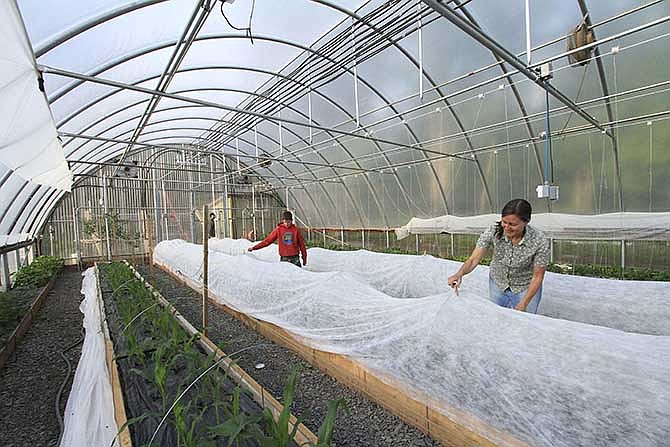PALMER, Alaska (AP) - Stephanie and Jim Gaiser take their cues for living from the Bible and say that when God created man, he put him in a garden.
"That was his first line of work," Stephanie Gaiser said. "We believe man is really in his element when he's in the garden. And since it's Alaska, you need a little help."
The Gaiser's Eden is a 72-foot seasonal high tunnel, a tall hoop house used to cover crops and extend the short growing season in a state with cold soil. Metal ribs hold plastic arching over soil or raised beds, which are heated by sunlight. That's in contrast to greenhouses, which are typically permanent, climate-controlled structures.
"We are vegetarians that care very much about our health," she said. "... Being in Alaska, the stuff you get in the store is not that great, and it's expensive."
Most commercially grown vegetables and fruits are shipped to Alaska from at least 1,400 miles away. High tunnels extend growing seasons for weeks on either end and create tiny microclimates that allow warm-weather crops to grow.
Qualified growers can obtain financial assistance from a federal program to build them. It's proved popular: Alaska ranks No. 1 among states that take advantage of the program. The U.S. Department of Agriculture's Natural Resources Conservation Service has spent about $4 million splitting the cost of high tunnels with Alaska growers.
Overall, there are 9,821 high tunnels in the U.S. - with Missouri, Michigan, Kentucky and Maine rounding out the top 5 states in subsidy funding - at a cost of $56.8 million. They fall under the USDA's Environmental Quality Incentives Program, which promotes voluntary practices that will improve soil, water, plant, animal, air or energy conservation.
The high tunnel effort started as a three-year pilot in 2010. The service wanted to support the local food movement, said Jeff White, who manages the program.
"The seasonal high tunnel was a way that we saw that we could benefit some of those small and limited resource producers, especially in northern climates, where they were growing small plots of fruit, vegetables, food on the ground," he said.
Vegetable farmer Vern Stockwell uses a high tunnel to grow English cucumbers to sell at Anchorage farmers markets. Lan Hecimovich of Palmer plants artichokes and tomatoes, and says he likes to know where his food comes from.
High tunnels must be purchased from a commercial manufacturer and constructed on land already in cultivation that has produced at least $1,000 in documented annual production. In Alaska, the USDA cap on federal payment for high tunnels is $16,000. Support is highest for "historically underserved" growers off the road system where equipment must be barged or flown in - $7.72 per square foot.
They have to be at least 6 feet tall, a height that provides enough length to roll up the sides for air flow and ventilation and for a tall person to work in the controlled environment. High tunnels also allow farmers to soil from erosions or nutrients from leaching in heavy rain, White said.
"You're going to make sure that those plants get exactly that they need, nutrient-wise," White said.
The Gaisers and their five children eat most of what they grow and last year sold extra basil, cucumbers and eggplant. Under raised beds in the Gaisers' 76-by-30-foot high tunnel, the family has planted rows of strawberries, eggplant, sweetcorn, cucumbers interspersed with spaghetti squash, tomatoes and garden greens.
While the USDA may have had northern gardens in mind when they launched the program, the high tunnels are also extending growing seasons in southern states and in urban garden plots in cities such as Detroit and Cleveland. In Alaska, the demand is expected to continue.
"Season extension. Start earlier. Go later. Grow things you can't grow outside," said Julie Riley, an Anchorage horticulturist with the University of Alaska Cooperative Extension Service. "It doesn't get any better than that."

